Cullernose Point

I’ve got too much art waiting to go up in my new house to be buying more at the moment, but I’m very tempted by these exquisite wood engraving prints from emeritus professor John Altringham, an ecologist and conservation scientist.
In particular, the one I’ve featured for this post is of a place in my home county of Northumberland that I’ve never visited: Cullernose Point. It also has given me some ideas for some mountain expeditions, something that I really need in my life at the moment.
Source: John Altringham
Systems ambiguity and chaos

Silvio Lorusso’s ‘intervention’ during Domus Academy’s roundtable is well worth a read. He talks about the need to, in some ways fight complexity as more of a cultural practice than a practical framework. How useful is it, he wonders, to point to something as ‘complex’? Is it mostly of help to professionals seeking to assert authority and control?
Disciplines are arbitrary compartments of knowledge: they strategically define their boundaries in order to demarcate some particular problems and solve them, or at least address them. Sociology, for example, was born in the early 19th century to address the problem (and, therefore, problems) of society. However, disciplines won’t meekly confine themselves within their artificial boundary; rather, their internal discourse will push the border, extending it. This tendency is especially evident in the design field, where you often hear that “everything is design”.
Besides the physiological swelling of the disciplines, we witness a phenomenon which is historically specific. Martin Oppenheimer (quoted by philosopher Donald Schön) called it a “proletarianization of the professions”. When everyone can call themselves a professional, the reputational and financial returns of being one shrink. Furthermore, there is a tangible distrust toward the figure of the expert. Just think of the field of economy or virology…
So, what do professionals do to regain prestige? They accelerate the expansion of the disciplinary confines, creating connections in an almost conspiratorial, apophenic mode. Carlo Bramanti, who is currently working on the notion of “conspiratorial design”, points out not only the visual but also the conceptual similarities between diagrams made by legitimized design figures like Victor Papanek and paranoid-style infographics about “Covid 5G” by an obscure graphic artist named Dylan Louis Monroe. What do they have a in common? They want to produce and project a sense of control on the messiness of the world (Richard Hofstadter: “the paranoid mentality is far more coherent than the real world, since it leaves no room for mistakes, failures, or ambiguities”). How do they do so? By means of hypertrophy: by adding always more relations to their system, which becomes a totalizing one: it becomes the system.
This is why complexity is ultimately a reassuring category. Reassuring to whom? To the professionals, who are there to explain and clarify it, to seal it with “the authoritative stain of scientific enquiry”, as Georgina Voss puts it. And there is a further paradox. Do you remember the Game of Thrones “It’s not that simple” meme? Well, to reassure themselves, experts will have an incentive to expand their system of reference, and therefore create more links and relationships. This leads to the ever-increasingly intricate diagrams, to what Voss calls “the airport-bookshop model of systems thinking which tends to involve a lot of graphs and urges to ‘shift your mindset’”. But by adding links and relationships one doesn’t necessarily reach galaxy brain level. More likely they will just generate more confusion, more noise, more chaos.
Source: Entreprecariat
Image: Bucky’s Nightmare by Mathieu Lehanneur.
But here we are: the diaspora of online communities
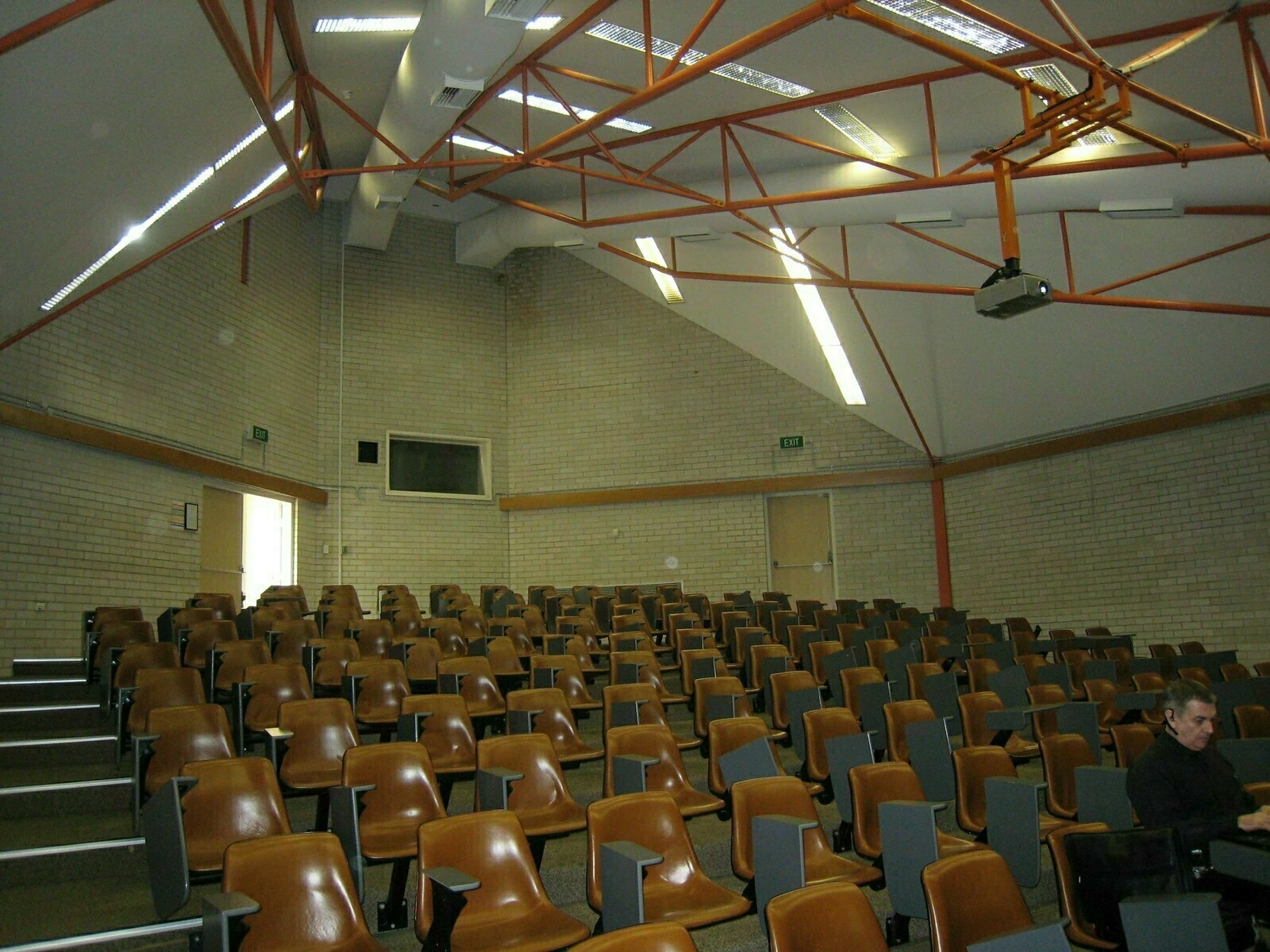
Laura often says that online communities don’t exist on a single platform, but all over the web. They might seem to have a ‘home’ in one place, but conversations and hashtags to gather around are distributed.
Twitter, says Alan Levine, was an anomaly in that regard. It felt like a ‘public square’ even though it was owned by a private company. As I said a decade ago, ‘software with shareholders’ is a problem. Something to avoid.
Now, I spend most of my social time on the Fediverse, but it’s not a place where I talk much about my professional work. That seems to have moved to LinkedIn, more from necessity than choice. It’s not a great state of affairs; I wish it were different. But here we are.
There is a myth. Cue the string section.
That there was once a place for all to gather, share, be festive, develop new connections, every course a hashtag, topple a few governments, people power.
Then came an evil billionaire who ruined it all, those who gathered were cast out, a diaspora.
No end.
Yes the Musky One was/is a horrible scourge, but all he did was hasten a decline. The birdhouse he bought was already uwinding in the mid 2010s with more algorithim cruft, more ads, more malfeasents. In my 2016 year end post, having been one of the world’s stupefied witness to the script of a reaility show election right out of the Black Mirror
[…]
It’s too simple, too convenient to scapegoat it all on that smelly tyrant, the reason for the dispersion is we dispersed. And it’s not a platform thing, it’s that thing in our hands.
Source: CogDogBlog
"All that any honest review actually does is just accelerate whatever was already going on"
This is a masterpiece in defending yourself while taking the high ground and explaining to your audience what it is that you actually do. Brownlee is an amazing communicator and there’s a reason why he’s got one of the most-watched YouTube channels.
Warm Data
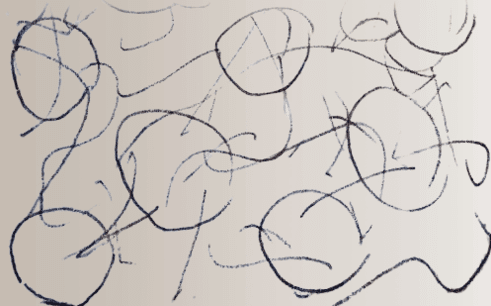
Amy Daniels-Moehle shared a link to this during the ORE community call yesterday. She’s been doing some kind of intensive course with the International Bateson Institute and mentioned the concept of ‘warm data’.
Nora Bateson explains the origin and need for warm data in this short video. It’s definitely something I need to explore further, perhaps as part of my studies towards a MSc in Systems Thinking.
The International Bateson Institute exists to generate and give access to information that offers a wider vision. The focus of inquiry is on the interrelational processes between and among systems. It can involve recognising how patterns repeat and reflect each other among multiple contexts and across multiple systems – many of these systems’maintenance and renewal is critical in the coming decades.
The underlying premise of the IBI is to address and experiment with how we perceive. Our work is to look in other ways so that we might find other species of information and new patterns of connection not visible though current methodologies.
We call this information “Warm Data”.
Spectacular timelapse over the ALMA Observatory
This timelapse, which was shared by the social media account Wonder of Science is just fantastic. It’s a timelapse capturing an entire night from sunset to sunrise over the ALMA Observatory on the Chajnantor Plateau in the Chilean Atacama Desert by Christoph Malin.
More information on the European Southern Observatory website.
How to easily generate image descriptions and alt text
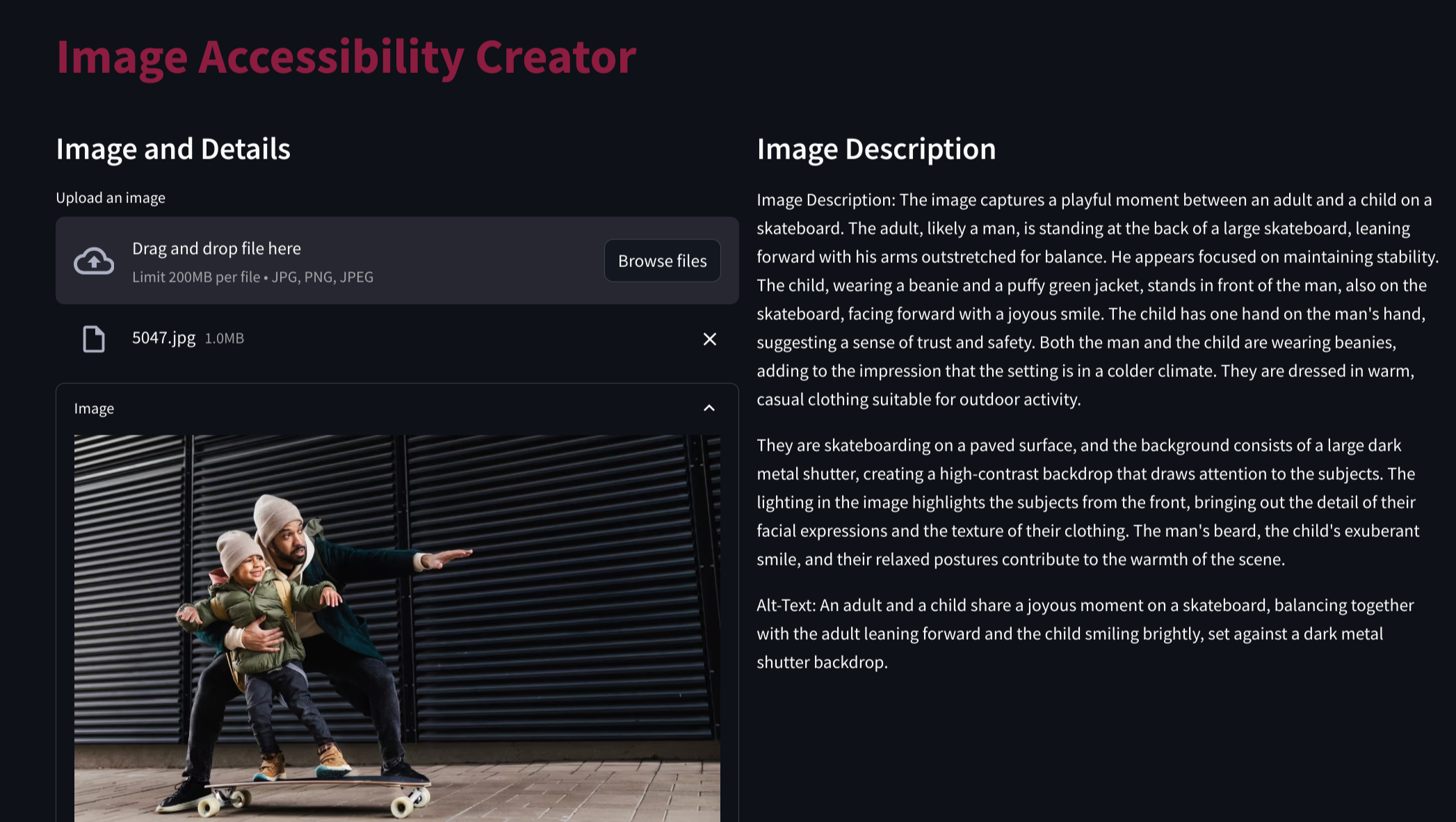
This is pretty great: you upload the image and it creates a pretty detailed text description, along with more concise alt text. I’ve previously been using GPT-4 for this, but this is more focused and useful.
Source: Arizona State University
It turns out the apple can fall pretty far from the tree

How much influence do parents have on their children? Less than we’d assume, it appears.
I have to say, much to my shame, that it’s taken me a long time to realise how different my own kids are to me. This shouldn’t be a surprise, as I’m quite different from my own parents. Although, of course, there are some pretty huge overlaps in our interests, but that’s to be expected, given how much time we’ve spent together.
[P]sychologists have known for ages that parents and children don’t particularly share the “big five” personality traits (extroversion, agreeableness, openness, conscientiousness and neuroticism). It is getting attention now because of a study that tried to change the way this question of family similarity is explored. Rather than participants only self-reporting their personality traits, they also chose a third party who knew them well to assess them.
This novel approach suggested more similarity between parents and offspring – approximately 40% rather than the 25% of previous studies. But that is still very low. The study concluded that it was “impossible to accurately predict a child’s personality traits from those of their mother or father” and that most relatives are not “much more similar than strangers”.
Huh. So it’s just our pattern-seeking brains that make us think little Timmy is “cheeky like his dad”; you might as well say he is “cheeky like that gull”. As a parent, this felt like a weight lifted: if my kids are like me (God help them), it’s not my fault – just dumb luck. The same study’s findings on the impact of home environment felt good, too: “Growing up together does not make people more similar.”
[…]
But parents aren’t entirely off the hook. Last year, a study of 9,400 11- to 17-year-olds declared: “Parent personalities have a significant impact on a child’s life.” The detailed results concluded: “Kids with neurotic parents scored relatively low on several measures, including grades, overall health, body mass index … and time spent on leisure activities.” (Sorry, kids, but it’s not just me and my fellow neurotics getting guilted: extroverts’ offspring also get worse grades.)
It would be bizarre if the people who raised us had no influence on how we turned out, but surely we will never understand with any clarity how our parents screw us up and how we screw up our kids in turn. There are too many variables; how could you ever work out what makes us who we are, what is innate and what isn’t? As one psychologist has put it, the most direct way to weigh nature against nurture is “to randomly assign children to parents”.
Source: The Guardian
Limiting virtues
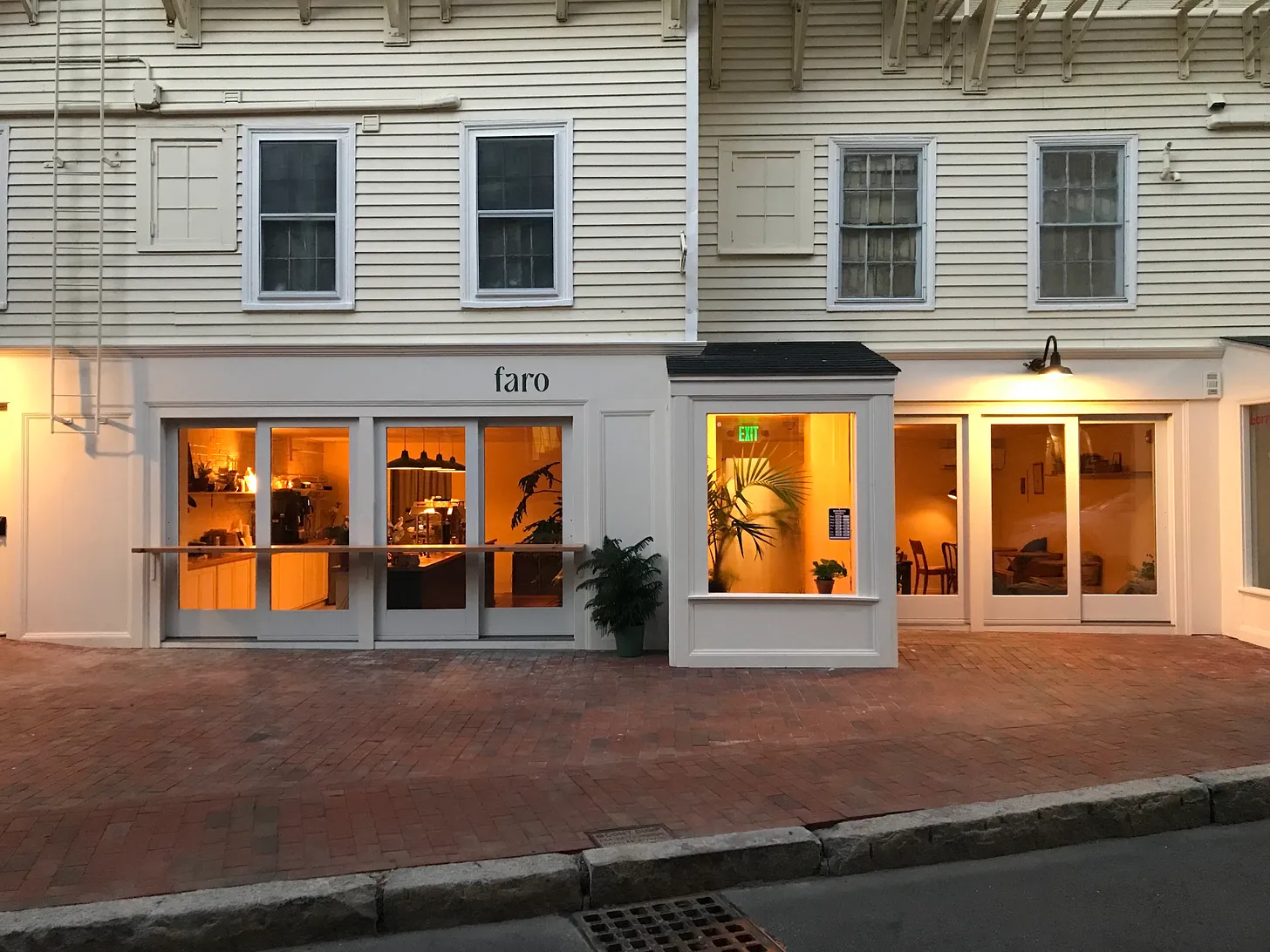
Sara Hendren discusses what I would call ‘creative constraints’ as applied to organisational policies. For example, a coffee shop she knows that has a no-laptops policy which is “gently, but strictly, enforced” changes the vibe:
A no-laptops policy means you can’t get a certain kind of work done, but it does mean everyone present will be a little more eyes-up-and-talking, or maybe absorbed by a book or notebook. The activities will be at the speed of the body, one to another. Is it nostalgic and precious? Maybe. But it’s not the only café in town to make this move, and I think there’s some signal there. Faro started out with no-laptops only on weekends, and the policy was welcome enough to make it a daily norm. Over at Zuzu’s Petals, it’s no devices of any kind.
Source: undefended / undefeated
You are what you read
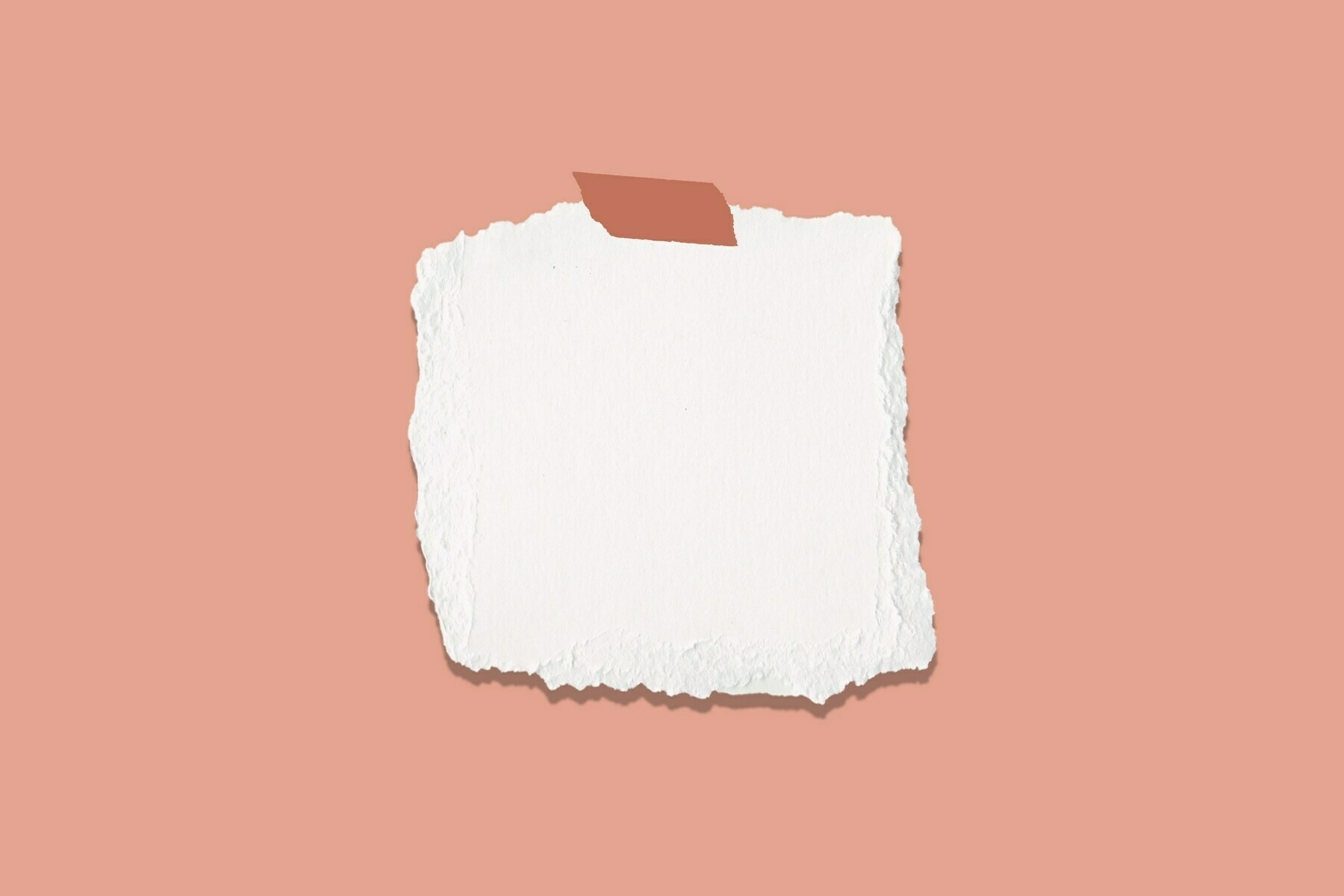
Jim Neilsen uses a Ralph Waldo Emerson quotation as a jumping-off point to discuss something important:
I cannot remember the books I’ve read any more than the meals I have eaten; even so, they have made me.
To me, all of those people with super-intricate systems, whether for academic work, pleasure, or something inbetween are faintly ridiculous. The point isn’t to replicate a machine and remember everything you’ve ever read.
Neilsen writes:
It’s a good reminder to be mindful of my content diet — you are what you
eatread, even if you don’t always remember it.
For me, I bookmark a bunch of stuff that I never get to reading properly. Some of it ends up here on Thought Shrapnel in a way that I can process and search through at a later date. The added bonus is that you, dear reader, also get to see it too.
Source: Jim Neilsen’s Blog
Image: Olga Thelavart
Book reading and secondary orality

This is a bit of a strange ramble-post which largely rehashes the discussion/debate we’ve been having for over 15 years about the qualitative difference between reading on screens versus reading on paper. The difference is that there is the added layer of moral panic about people reading fewer books.
What is rarely included in this kind of thing is that we are emerging from what Walter Ong called the Gutenberg Parenthesis, a time in which the written word dominated. That wasn’t true before the printing press, and it’s unlikely to be true going forward given the preponderance of new media. This post-Gutenberg phase is known as ‘secondary orality’ as it depends upon literate culture.
I will always prefer the written word, mainly because it’s more information dense than video and audio content. But there’s room for everything without endless hand-wringing.
The e-reading apps have their merits. At times, they become respites from the other, more addictive apps on my phone. Switching to a book from, say, Twitter, is like the phone-scroller’s version of a nice hike—the senses reorient themselves, and you feel more alert and vigorous, because you’ve spent six to eight minutes going from seven to eleven per cent of Arthur Koestler’s “Darkness at Noon.” Or you might feel a sense of pride because you’ve reached the sixty-per-cent mark in Elton John’s autobiography, “Me,” which isn’t a great work of literature but at least is better than Twitter. The book apps also seem to work as a stopgap for children, who are always lusting after screen time of any sort. My seven-year-old daughter has read hundreds of books on the Libby app, which lets you check out e-books from public libraries you belong to. As a parent, I find this wildly preferable to hearing the din of yet another stupid YouTube short or “Is it Cake?” episode coming through her iPad’s speakers.
Still, the arrival of these technologies has been accompanied by a steady decline in the number of books that get read in any form. A pair of 1999 Gallup polls, for example, found that Americans, on average, had read 18.5 books in the course of the previous twelve months. (It should be noted that these were books people had read, or said they had read, “either all or part of the way through.”) By 2021, the number had fallen to 12.6. In 2023, a National Endowment for the Arts survey found that the share of American adults who read novels or short stories had declined from 45.2 per cent in 2012 to 37.6 per cent in 2022, a record low. There are plenty of theories about why this is happening, involving broad finger-pointing toward the Internet or the ongoing influence of television, or even shifting labor conditions, as more women have entered the workforce.
Source: The New Yorker
Optimising for the wrong things

Solid advice here.
You aren’t famous. Anything you do or create will probably receive little to no attention, so stop optimizing for a non-existent audience and instead focus on what makes you enjoy the activity.
[…]
The most egregious thing you can do with any activity is daydream about how you can make money off of it. That’s the quickest way to optimize for the wrong things and suck the fun right out of it. Most likely you will stop doing the activity almost immediately, so save the money-making schemes for work.
In the end, find something you enjoy doing and just do it because you enjoy it. If you have to, make some goals for yourself, but never for your “audience”.
Source: Ash Newman
Image: Elena Mozhvilo
There's only so much lemonade you can make when life is firing lemons at you
I just had to post this image, which I discovered via the Fediverse. It’s definitely a riposte to all of those people who say that people who have been underserved and marginalised by a biased system should “try harder,” “be more resilient,” or “show more grit”.
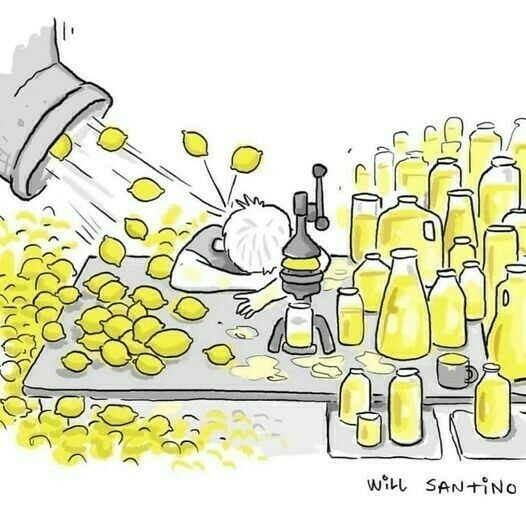
Real-time deepfake videos for fun and exploitation

This is a PSA to be careful out there: deepfakes have come to regular, real-time video calls. People are getting scammed.
The Yahoo Boys have been experimenting with deepfake video clips for around two years and shifted to more real-time deepfake video calls over the last year, says David Maimon, a professor at Georgia State University and the head of fraud insights at identity verification firm SentiLink. Maimon has monitored the Yahoo Boys on Telegram for more than four years and shared dozens of videos with WIRED revealing how the scammers are using deepfakes.
[…]
The Yahoo Boys’ live deepfake calls run in two different ways. In the first, shown above, the scammers use a setup of two phones and a face-swapping app. The scammer holds the phone they are calling their victim with—they’re mostly seen using Zoom, Maimon says, but it can work on any platform—and uses its rear camera to record the screen of a second phone. This second phone has its camera pointing at the scammer’s face and is running a face-swapping app. They often place the two phones on stands to ensure they don’t move and use ring lights to improve conditions for a real-time face-swap, the videos show.
The second common tactic… uses a laptop instead of a phone. (WIRED has blurred real faces in both videos.) Here, the scammer uses a webcam to capture their face and software running on the laptop changes their appearance. Videos of the setup show scammers are able to see their own face alongside the altered deepfake, with just the manipulated image being displayed over the live video call.
[…]
Some of the Yahoo Boy videos are unbelievable, obvious fakes, while others appear plausible. When they’re viewed live, on a mobile phone, with unstable connections, any obvious flaws may be masked—especially if a scammer has spent months social-engineering their victim.
[…]
Ronnie Tokazowski, the chief fraud fighter at Intelligence for Good, which works with cybercrime victims, says because the Yahoo Boys have used deepfakes for romance scams, they’ll pivot to using the technology for their other scams. “This is kind of an early warning where it’s like: ‘OK, they’re really good at doing these things. Now, what’s the next thing they’re going to do?’”
Source: WIRED
It's not sick note culture, it's systemic failure in governance

This is, as you’d expect, a restrained article from the BBC. But it still flies in the face of the government’s talk of a ‘sick note culture’ in the UK. Instead, as anyone lives here will attest, it’s the financial crisis, Brexit, and the pandemic, compounded by repeated government failure — including underfunding the NHS.
Research by the Health Foundation shows there are as many people aged 16 to 64 in work whose health limits what they can do as they are out of work because of ill-health.
Overall, it estimates nearly a fifth of the working-age population in the UK has what it calls a work-limiting condition.
In fact, the think tank believes the problem has become so bad that it is threatening the economic potential of the country.
[…]
So why are working-age people so ill? Christopher Rocks, who heads up the Health Foundation’s work in this area, says it is a “complicated” picture.
He says while there has been a lot of focus on the issue since the pandemic, the trend has actually been developing for the past decade at least.
“The 2008 financial crisis had a major impact on society - we saw an economic downturn and public spending cuts. That had an impact on people’s health in many different ways. The pandemic and subsequent cost of living crisis exacerbated trends, but the signs were there before Covid hit.
“Access to health care has become more difficult, while those fundamental building blocks of health - such as good housing and adequate incomes - are under strain.”
How that has affected people varies depending on their age and where they live. Research published this week warned the numbers with major illness was set to increase significantly. with the people in the most deprived areas suffering the most - many with multiple conditions.
The work, also published by the Health Foundation, found there were three main conditions causing a significant burden of ill-health: chronic pain, type 2 diabetes and mental health problems. Each is a reflection of the different challenges facing the country.
Source: BBC News
Book publishing doesn't work
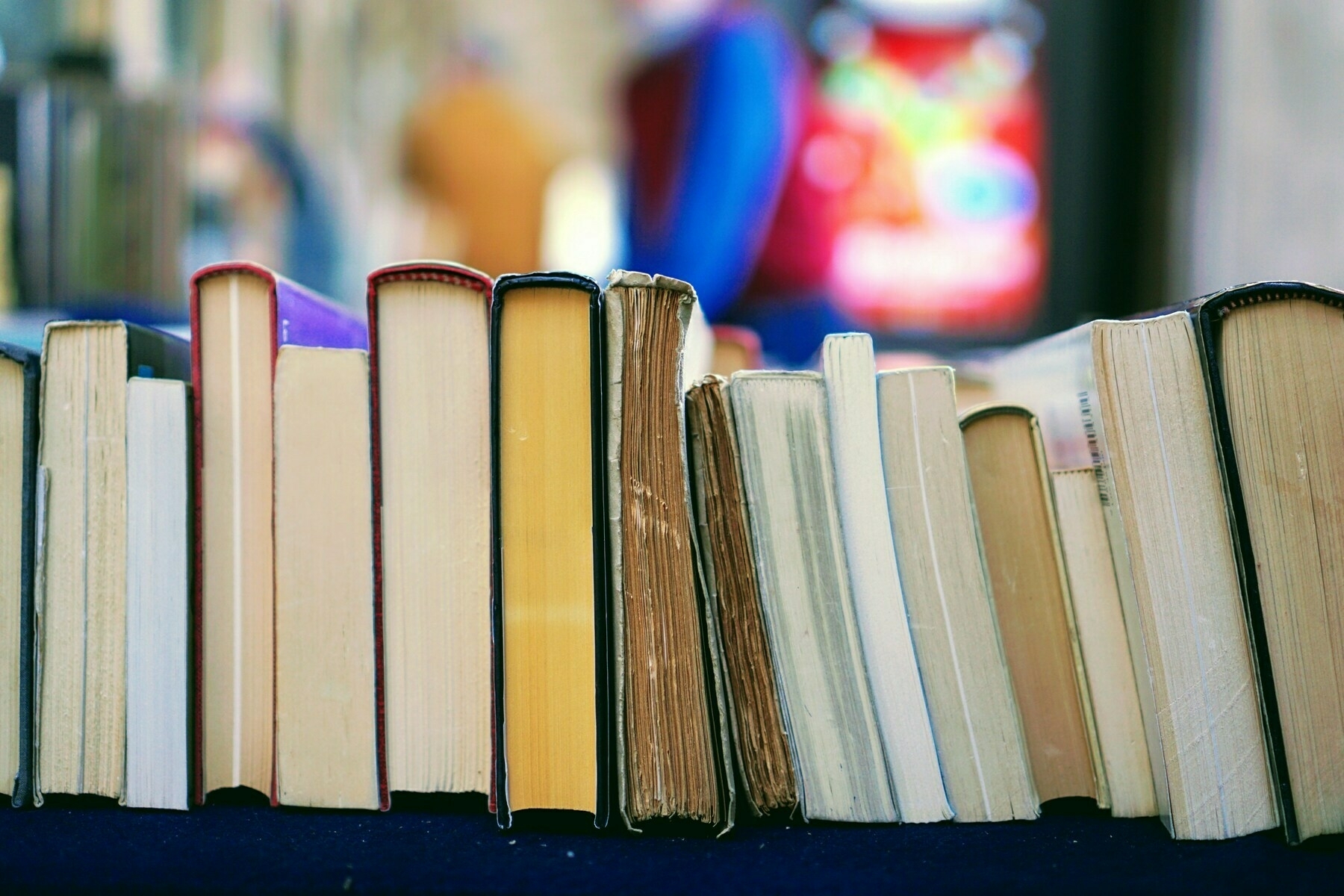
Elle Griffin digged into the details of a court case from 2022 that involved Penguin Random House attempting to acquire another publishing house, Simon & Schuster. Some of the details shared are eye-opening.
I don’t think the models used by the book industry, or the academic publishing industry, are long for this world.
I think I can sum up what I’ve learned like this: The Big Five publishing houses spend most of their money on book advances for big celebrities like Brittany Spears and franchise authors like James Patterson and this is the bulk of their business. They also sell a lot of Bibles, repeat best sellers like Lord of the Rings, and children’s books like The Very Hungry Caterpillar. These two market categories (celebrity books and repeat bestsellers from the backlist) make up the entirety of the publishing industry and even fund their vanity project: publishing all the rest of the books we think about when we think about book publishing (which make no money at all and typically sell less than 1,000 copies).
[…]
The DOJ’s lawyer collected data on 58,000 titles published in a year and discovered that 90 percent of them sold fewer than 2,000 copies and 50 percent sold less than a dozen copies.
[…]
Having a lot of social media followers or fame doesn’t guarantee it will sell. The singer Billie Eilish, despite her 97 million Instagram followers and 6 million Twitter followers, sold only 64,000 copies within eight months of publishing her book. The singer Justin Timberlake sold only 100,000 copies in the three years after he published his book. Snoop Dog’s cookbook saw a boost during the pandemic, but he still only sold 205,000 copies in 2020.
[…]
The publishing houses may live to see another day, but I don’t think their model is long for this world. Unless you are a celebrity or franchise author, the publishing model won’t provide a whole lot more than a tiny advance and a dozen readers. If you are a celebrity, you’ll still have a much bigger reach on Instagram than you will with your book!
Personally, I could not be more grateful to skip the publishing houses altogether and write directly for my readers here, being supported by those who read this newsletter rather than by a publishing advance that won’t ultimately translate to people reading my work.
Source: The Elysian
Image: Tom Hermans
Social media without an audience

What I appreciate about Drew Austin’s writing is how concisely he can string together important points. Go and read the three long paragraphs of this post, which I’ve summarised out of order below.
My understanding is that Austin is saying that our mental model of social media is out of kilter with the current reality. We’re pretending that the current landscape is in any way similar to that of a decade ago.
[A] 2021 essay, The Brazilianization of the World by Alex Hochuli, describes how “the fate of being modern but not modern enough now seems to be shared by large parts of the world: WhatsApp and favelas, e-commerce and open sewers.” As a small cohort of venal elites separates itself, physically and socially, from the much larger and poorer population in which it’s embedded, it creates an idea of interior and exterior existence. The Twitch streamer with no audience anticipates life on the outside, in the dead public space of a Brazilianized, enclave-gated internet, a ground that shifted under our feet with little warning, turning us into street buskers playing music we didn’t realize no one could hear.
[…]
Talking to no one is the near future of social media, the digital equivalent of warming your hands over an oil drum bonfire in an abandoned city—what you do when you missed the last bus out of town and have to loiter as comfortably as possible in the ruins. We may have once imagined that social media would ultimately end by imploding suddenly, releasing us from the last day of school into a summer of the real, but no such catharsis is coming. When institutions die now, they rarely give us the closure of ceasing to exist—they live on in zombie form, and we learn to tolerate the gradually worsening conditions they impose. We stick around Twitter because we need to for professional reasons, we may tell ourselves, but the real job is just scavenging copper wires from the wreckage.
Source: Kneeling Bus
Image: Patrick Busslinger
How not to mince about like a little weasel

It would be remiss of me not to mark the extraordinary achievement of Russell “Hardest Geezer” Cook, who has run the entire length of Africa. This interactive map not only charts the daily progress he made, but links to his social media accounts.
My favourite part of the story, which backs up his nickname, comes when he had scans due to persistent back pain. Finding no bone damage, he concluded that “the only option left was to stop mincing about like a little weasel, get the strongest painkillers available and zombie stomp road again”.
Incredible.
The 27-year-old from Worthing, West Sussex, said he had struggled with his mental health, gambling and drinking, and wanted to “make a difference”.
After running through 16 countries, he has raised in excess of £700,000 for charity and has completed his final run.
As he crossed the finish line at about 16:40 BST in Ras Angela, Tunisia, Mr Cook was greeted by a shouting crowd, with many chanting “geezer”.
“I’m pretty tired,” he told reporters and in a post on X, formerly known as Twitter.
Source: BBC News
Tearing your anger into strips

A new paper in Nature suggests that writing down your feelings of anger and then disposing of the piece of paper can rid yourself of the angry feelings. Interestingly, or tellingly, the paper starts by talking about parental anger and the importance of demonstrating emotional self-regulation.
I’ve done something similar in terms of emotional processing with my own kids. For example, when my son was around four years old, the bird hide in the park behind our house was set on fire deliberately. An act of arson. He was inconsolable, and had nightmares. I got him to draw a picture of what had happened and to use it to talk about what happened, which seemed to be cathartic.
Anger suppression is important in our daily life, as its failure can sometimes lead to the breaking down of relationships in families. Thus, effective strategies to suppress or neutralise anger have been examined. This study shows that physical disposal of a piece of paper containing one’s written thoughts on the cause of a provocative event neutralises anger, while holding the paper did not. In this study, participants wrote brief opinions about social problems and received a handwritten, insulting comment consisting of low evaluations about their composition from a confederate. Then, the participants wrote the cause and their thoughts about the provocative event. Half of the participants (disposal group) disposed of the paper in the trash can (Experiment 1) or in the shredder (Experiment 2), while the other half (retention group) kept it in a file on the desk. All the participants showed an increased subjective rating of anger after receiving the insulting feedback. However, the subjective anger for the disposal group decreased as low as the baseline period, while that of the retention group was still higher than that in the baseline period in both experiments. We propose this method as a powerful and simple way to eliminate anger.
Source: Nature
If you're going to go, you might as well go... weirdly?

I stumbled across a Wikipedia page entitled ‘List of unusual deaths’. I was only going to share three of them, but there are so many bizarre ones on there that I couldn’t help sharing more.
Sigurd the Mighty of Orkney (892 CE): The second Earl of Orkney strapped the head of his defeated foe Máel Brigte to his horse’s saddle. Brigte’s teeth rubbed against Sigurd’s leg as he rode, causing a fatal infection, according to the Old Norse Heimskringla and Orkneyinga sagas.
Hans Staininger (1567): The burgomaster of Braunau (then Bavaria, now Austria), died when he broke his neck by tripping over his own beard. The beard, which was 4.5 feet (1.4 m) long at the time, was usually kept rolled up in a leather pouch.
Thomas Otway (1685): The English dramatist fell on hard times and was suffering from poverty in his later years, and was driven by starvation to beg for food. A gentleman who recognized him gave him a guinea, with which he hastened to a baker’s shop, purchased a roll, and choked to death on the first mouthful.
John Cummings (1809): After seeing a circus knife-swallower, seaman John Cummings began actually swallowing knives. On one occasion, he swallowed four knives, and quickly passed three with no ill-health. He later swallowed 14 knives, and after some days with abdominal pain, he passed all of them. He finally swallowed 20 knives and a clasp knife case, but after a few days, he had only passed the case; he died after four years in pain. On autopsy, a knife blade and spring were found in his intestines, and between 30 and 40 fragments of metal, wood, and horn in his stomach.
Mathilda of Austria (1867): The daughter of Archduke Albrecht, Duke of Teschen set her dress on fire while trying to hide a cigarette from her father, who had forbidden her to smoke.
Sir William Payne-Gallwey, 2nd Baronet (1881): The former British MP died after sustaining severe internal injuries when he fell on a turnip while hunting.
Thornton Jones (1924): The lawyer from Bangor, Gwynedd, Wales, woke up to find that he had his throat slit. Motioning for a paper and pencil, he wrote, “I dreamt that I had done it. I awoke to find it true”, and died 80 minutes later. He had done it himself while unconscious. An inquest at Bangor delivered a verdict of “suicide while temporarily insane”.
Isadora Duncan (1927): The American dancer broke her neck in Nice, France when her long scarf became entangled in the open-spoked wheel and rear axle of the Amilcar CGSS automobile in which she was riding.
David Grundman (1982): While shooting at cacti with his shotgun near Lake Pleasant Regional Park, Arizona, he was crushed when a 4-foot (1.2 m) limb detached and fell on him.
Vladimir Likhonos (2009): The 25-year-old student of Kyiv Polytechnic Institute from Konotop was killed when his chewing gum exploded. He had a habit of dipping his chewing gum in citric acid to increase the gum’s sour taste. On his work table police found about 100 grams (3.5 oz) of unidentified explosive powder which he used for chemistry studies at home. It resembled citric acid, and it is thought that he confused the two, having accidentally coated his gum in the explosive powder before chewing it. The explosive was found to be four times stronger than TNT, and the explosion was possibly triggered either by reacting with Likhonos’s saliva, or the pressure exerted by him chewing on the gum and explosive powder.
Ilda Vitor Maciel (2012): The 88-year old died in a hospital in Barra Mansa, Rio de Janeiro, allegedly as a result of nursing technicians injecting soup through her intravenous drip instead of her feeding tube.
Sam Ballard (2018): The 29-year old from Sydney, Australia, died from angiostrongyliasis after eating a garden slug as a dare eight years earlier.
Shivdayal Sharma (2023): The 82-year-old was reportedly urinating next to a train track in the region of Alwar, India, when a cow was hit by the Vande Bharat express train. The animal was launched 100 feet (30 m) into the air before landing on Sharma, killing him instantly.
Source: Wikipedia
Image: The death of Aeschylus, killed by a turtle dropped onto his head by a falcon